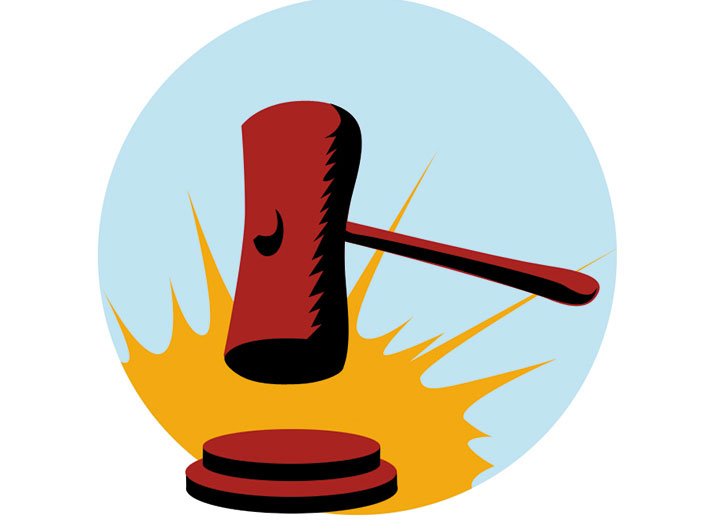Three new books throw light on the fault lines and the shining spots of our courts
While judging a book by its cover is considered unfair, judging it by its title should not lead to the same charge, especially when the author – a veteran of legal profession, an acclaimed commentator or a widely acknowledged academic – decides to warn the reader at the onset, through the title itself, that the pages that follow shall tell a story of a decay in an institution.
In Anita Gets Bail: What Are Our Courts Doing? What Should We Do About Them?, Arun Shourie, editor-turned-politician, highlights the cracks in the Indian judicial system, both at the highest institutional level and at the lowest level of day-to-day functioning of lower courts.
He begins with a chapter that presents a distressing picture of the judiciary. He recounts in vivid detail the harassment he and his wife, a patient of Parkinson’s, had to face for a house they never built on a plot they did not own.
Shourie with detailed elaboration, but much ease, reflects upon the most important problem within our judicial system and that is delay in the judicial process – an issue which of course concerns the common man most, more than what he prefers to call “lofty constitutional issues” being debated in the supreme court.
Discussing the disproportionate assets (DA) case against former Tamil Nadu chief minister J Jayalalithaa he raises some very important points that are pertinent to survival of our judicial system. While going through the finer points of the case, he writes that while the 2017 judgment by the apex court, which restored the decision of the special judge John Michael D’Cunha who had convicted Jayalalithaa, “gave confidence that the Supreme Court is there to see that eventually justice will have done”, but it came after the Karnataka high court had in 2015 overturned justice D’Cunha’s verdict, paving the way for Jayalalitha’s return to power. “If a High Court judge could resort to such incredible distortions in such a conspicuous case—the judgment on which, he might have apprehended, would be scrutinised far and wide—what was he not capable of doing in run-of-the-mill cases judgments on which, he could be confident, would not attract attentions other than of the parties directly affected?”

Elsewhere in the book, Shourie argues in favour of judicial activism and what many call judicial overreach, and while one may not agree with all his conclusions his arguments remain impeccable. However, he does not forget to put riders for such ‘activism’. In the chapter on judicial overreach, he writes, “The more activist a court is, the more every judge must be seen to be a paragon of virtue and impartiality.” Also: “When the court feels compelled to intervene, it must ensure that its orders are obeyed to the dot, that its reputation must always be spotless.”
Shourie’s approach is exhaustive, dealing with almost every important issue that concerns the judicial system today, including the controversial corruption in courts. He illustrates the latter with the infamous cash-at-judge’s-door scam in which Punjab and Haryana High Court judge Nirmal Yadav was charged with taking bribe. Also under discussion is the failure of the collegium in appointing right persons, highlighted in several instances – most recently in the case of justice CS Karnan.
Appointment of Judges To The Supreme Court Of India: Transparency, Accountability And Independence, edited by Arghya Sengupta and Ritwika Sharma, provides perhaps the most comprehensive analysis of one of the most important issues related to the independence of judiciary: the method of appointment.
The turf war between the executive and the judiciary is not new, and one of their contentious issues is whether the government should have a say in the judicial appointments. The government brought in the National Judicial Appointments Commission (NJAC) Act in 2014, aiming to replace the decades-old ‘opaque’ collegium system, but the supreme court struck it down the next year, calling it unconstitutional. This was followed by a complete deadlock on the memorandum of procedure (MoP) which was to provide for the institutional structure for the appointment of judges.
Justice Jasti Chelameswar, who was the sole dissenting voice in the NJAC case, notes in the foreword to this book: “Various societies in the modern world adopted different models of selection processes for the appointment of judges. India choose a model when it became a republic. But the model is largely based on past colonial practice. With changing times and changing economic and political factors, the need to revisit the model was felt from time to time, both by successive governments and civil society. The latest experiment was the constitution (99th Amendment) Act, 2014, which was struck down by the Supreme Court …”
These lines become a subtext for all the essays in the book which dwells on various philosophical and constitutional aspects of the appointments to the higher judiciary.
In this detailed study of the past and the present of the judicial appointments in India, a perceptive comparative study of judicial appointments process in six countries – the UK, South Africa, Canada, Pakistan, Sri Lanka and Nepal – is also undertaken.
The impressive set of contributors to this volume includes senior advocates Arvind Datar, Raju Ramachandran, Gopal Subramaniam, Mukul Rohatgi, late Tehmtan Andhyarujina, former SC judge KT Thomas, political scientist Pratap Bhanu Mehta, and distinguished legal scholars like Peter McCormick and Rehan Abeyratne. They provide engaging arguments on the different aspects of appointment of judges and its impact on judicial independence.
The volume, with its comprehensive set of articles, provides enough material for anyone interested in the ongoing debate of judicial appointment.
The third book is from a former supreme court judge who is known for his no-holds-barred statements and judgments, and can be credited for delivering some of the most scathing in-house criticism of the judiciary, as a sitting apex court judge and later as a commentator.
Justice Markandey Katju, author of Whither Indian Judiciary makes the purpose of writing the book much clear at the beginning. It becomes clear that instead of finding answers to some deep constitutional issues, his attempt is to dwell on those issues that are actually paralysing the judicial system.
He writes that for satisfactory functioning of judiciary, three things are necessary: the judges should be honest, the judgments should be given on certain settled legal principals, and there should not be a delay in deciding cases. And then he poses the most pertinent question that makes for most of the book. The question is simple and straight: Are all these requirements being met?
Justice Katju chooses to give ample space to the issue of appointment of judges as part two of the book is entirely focused on it. He also analyses in great detail the contempt power of the court which can act as a barrier in exposing cases of corruption in the higher judiciary.
Discussing at length various cases of contempt, he writes, “Over the last half a century and more, the judiciary has been the one institution that has, by and large, served the country well. The respect and authority it has commanded flow from this record and it is hardly in need of artificial props such as the power to punish for the offence of scandalising the court.”
He adds, “If people are deterred from voicing their opinions strongly, they are inhibited even more from criticising the conduct of judges and bringing to light impropriety and corruption. For, if a person were then to be hauled up for scandalising the court, even truth would not be defence…the very basis of the offence of scandalising the court is flawed ad runs counter to the values of a democratic society with a republican form of government. It is time that the offence ceased to exist.”
As an insider who presided over the highest bench of the Indian judicial system, Justice Katju with much ease provides a perspective that clearly highlights the fault lines as well as the shining spots of the higher judiciary.
All the three books have a timely release and touches upon all the pressing issue around which debate on state of affairs in judiciary is being moderated. The three books together provide, by all means, a 360-degree view of all the issues that concerns Indian judiciary today.
feedback@governancenow.com
(The article appears in the August 31, 2018 issue)

